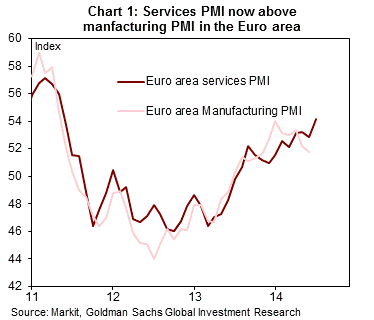It is unclear how much of this morning’s momentum-busting weakness in futures is the result of China’s horrendous Service PMI, which as we reported last night dropped to the lowest print on record at the contraction borderline, but whatever low volume levitation was launched by the market after Europe’s close yesterday may have fizzled out if only until Europe close (there is no POMO today). Still, futures may have been helped by yet another batch of worse than expected European data, namely the final Eurozone PMI prints, which in turn sent the EURUSD to day lows and the offsetting carry favorite USDJPY to highs, helping offset futures weakness. Because in the New Normal there is nothing like a little bad macro data to goose the BTFATH algos…
Speaking of the final European July PMI, here is what was reported a few hours ago, via Goldman: July Euro area Final Composite PMI came in at 53.8, 0.2pt weaker than the Flash estimate. Relative to June, the Composite PMI increased by 0.9pt. The country breakdown showed improvements in Germany, France and Spain, but a decline in Italy.
The Final manufacturing PMI (released last Friday) came in 0.1pt lower than the Flash estimate. Today’s data showed that the Final Services PMI printed 0.2pt below the Flash. The July data showed that the Manufacturing PMI remained stable at 51.8 for the month. In contrast, the Services PMI rose 1.3pt to 54.2. The Manufacturing PMI rose above the Services PMI in late 2013, but this relative outperformance has reversed of late (Chart 1).
Today’s data showed differing developments in Italy and Spain. Following June’s robust gain, the Italian Composite PMI fell 1.1pt in July to 53.1, as both the Manufacturing and Services PMI eased around 1pt. The Spanish Composite PMI rose 0.5pt to 55.7 in July: the 0.7pt decline in the Manufacturing subcomponent was more than offset by a robust (1.4pt) increase in the Services PMI. Overall, both Spanish and Italian Composite PMIs remain high relative to historical standards (Chart 2). At 53.8, the Euro area PMI is consistent with growth of around +0.5%/+0.6%qoq in early Q3, broadly similar to the Q2 average. The early reading of our Current Activity Indicator (CAI) for July points to a rate of expansion of around 1.3%, slightly below the Q2 average.


Â
Aside from the PMI data, European equities benefited from strong earnings, with outperformance in the benchmark CAC and DAX indices after Credit Agricole, BMW and Deutsche Post reported better-than-expected metrics. Furthermore, M&A news buoyed Vivendi as Telefonica tabled a bid for the Co.’s Brazilian GVT unit, lessening the likelihood of an offer for Telecom Italia’s TIM Brazil unit. As a result, Telecom Italia shares were halted limit down halfway through the trading day. 17 out of 19 Stoxx Europe 600 sectors rise; chemicals, media outperform, telcos, travel & leisure underperform. 73.2% of Stoxx 600 members gain, 24.5% decline. Eurostoxx 50 +0.5%, FTSE 100 +0.5%, CAC 40 +0.6%, DAX +0.6%, IBEX +0.2%, FTSEMIB -0.4%, SMI +0.9%
Turning to Asia, the Chinese data has sent the AUD (-0.17%) and Copper (-0.2%) a touch lower overnight. In Japan, Reuters is reporting that BOJ officials are concerned about increasing signs of weakness in the Japanese economy following a recent sales tax increase. The article says that the central bank’s Board will discuss at their policy meeting this week whether to downgrade their outlook for exports and industrial production. This comes after a number of Street forecasters have downgraded their Japan Q2 GDP growth estimates. In EM Asia, Indonesia has proposed limiting the amount of government-subsidised fuel to the public, which is expected to benefit the government’s fiscal position. The IDR is 0.3% stronger against the greenback today. The RBA has kept policy unchanged at today’s meeting. Asian stocks fall with the Sensex outperforming and the Nikkei underperforming. MSCI Asia Pacific down 0.6% to 147. Nikkei 225 down 1%, Hang Seng up 0.2%, Kospi down 0.7%, Shanghai Composite down 0.2%, ASX down 0.4%, Sensex up 0.7%
Staying in Asia, Bloomberg is reporting that the HK Monetary Authority has again intervened in the FX market to defend the USDHKD peg after recent local currency strength. The HKMA bought $925m yesterday, adding to the $8.4bn it purchased in July. Bloomberg is saying that some Russian companies are converting cash holdings to HKD in case of a further development of tensions between Russia and the West. Apart from a recent inflow of Russian cash, the article also notes that expectations of an improvement in Chinese growth and local corporate activity have been driving up demand for HKD.

